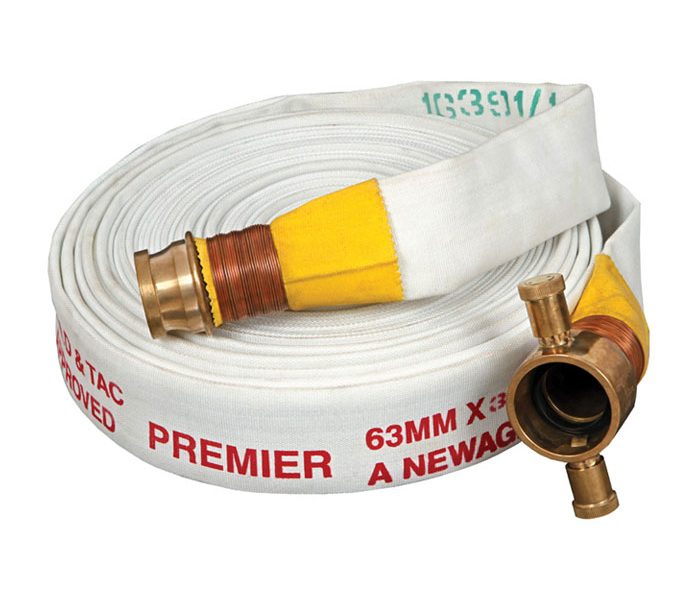A fire hose is a high-pressure tube designed to carry water or other fire suppression agents (such as foam or chemicals) to extinguish fires. Fire hoses are a crucial component of firefighting equipment and are used by firefighters to deliver a controlled stream of water onto a fire to suppress or extinguish it. These hoses are flexible, durable, and come in various types to suit different firefighting needs.
Types of Fire Hoses

Fire hoses are an integral part of fire-fighting equipment. They are designed to convey water or other fire retardants to extinguish fires. There are several types of fire hoses, each designed for specific applications:
- Attack Hose: This is the most common type of fire hose used by the fire department. It is typically lightweight and designed to combat fires by delivering water or other fire retardants directly onto the fire. The attack hose is often used in conjunction with a nozzle that can adjust the flow and direction of the water.
- Supply Hose: These are larger hoses, often ranging from 1.5 to 5 inches in diameter. Supply hoses are designed to move large volumes of water from a hydrant or other pressurized water source to the fire pump on a fire engine.
- Suction Hose: These hoses are used to draw water from an unpressurized supply, such as a portable water tank, pool, or other static water source. They operate under negative pressure and are typically used in rural areas where hydrants are not available.
Testing Parameters of Fire Hoses
Fire hoses undergo rigorous testing to ensure their quality and effectiveness. These tests are designed to assess the hose’s durability, flexibility, and resistance to various environmental conditions. Here are some of the key testing parameters:
- Internal Diameter: The internal diameter of a fire hose is crucial as it determines the amount of water that can be delivered. It is checked using a conical or cylindrical plug gauge of required sizes.
- Length: The length of the hose is important as it determines the distance over which water can be delivered. It is measured using a tape.
- Coil Diameter: The coil diameter is a measure of the hose’s flexibility and is checked using a steel scale.
- Hydrostatic Proof Pressure Test: This test is performed using hydrostatic pressure testing equipment. It checks the hose’s ability to withstand the working pressure.
- Hydrostatic Burst Pressure Test: This test checks the hose’s ability to withstand pressure beyond its maximum working pressure without rupturing.
- Adhesion Test: This test checks the adhesion between the different layers of the hose.
- Change in Length: This parameter is checked after the hose has been subjected to pressure. It ensures that the hose does not elongate or shorten under pressure, which could affect its performance.
Where are Fire Hoses Used?
- Outdoors: Fire hoses attach to a fire engine, fire hydrant, or a portable fire pump.
- Indoors: They can permanently attach to a building’s standpipe or plumbing system.
- Industrial Facilities: Fire hose reels are an integral part of fire safety systems in industrial facilities.
- Commercial Buildings: Fire hoses provide commercial end-users with fire safety in offices and commercial buildings.
- Residential Areas: They are also commonly found in residential areas.
Who are the Users of Fire Hoses?
- Firefighters: Firefighters are the primary users of fire hoses.
- Municipal Fire Services: Fire hoses are indispensable to the municipal fire service industry because of their key role in suppressing widespread fire.
- Industrial Users: Industrial users also use fire hoses, especially in environments where there’s a risk of fire.
- Commercial End-Users: In offices and commercial buildings, fire hoses are usually stored with a hose reel in a fire safety cabinet, along with other fire safety equipment.
Maintenance of Fire Hoses
Proper maintenance is crucial to ensure the longevity and effectiveness of fire hoses. Here are some key aspects of fire hose maintenance:
- Proper Usage: Avoid dragging the hose on the ground whenever possible, especially over abrasive surfaces or sharp edges which could cut or tear the hose. If you must drag the hose, use a tool such as a hose roller to minimize damage. Also, avoid using the hose above its rated working pressure.
- Cleaning and Drying: Clean your fire hose following each use to extend its usable life. Unroll the fire hose on a clean surface and gently stretch it out to remove any kinks. Thoroughly brush any dirt off of the hose using a clean dry brush with soft or medium bristles. If the hose was exposed to hazardous materials such as gasoline or oil, it must be washed and decontaminated using an approved method for the contaminant. Once properly washed, wipe dry hoses that are covered with rubber, nitrile, or other protective exteriors.
- Regular Checks: Regular maintenance checks, including visual inspections, operational checks, lubrication, cleaning, and testing, will help keep your fire hose reel system in optimal condition, ready for use in emergencies.
Remember, a well-maintained fire hose is not just a tool, but a lifeline in times of danger.
Conclusion
At NewAge Fire Fighting Company Limited, we understand the importance of quality, type, and application in fire hoses. We are committed to manufacturing fire hoses that meet the highest standards and serve their purpose effectively. Remember, a quality fire hose is not just a tool, but a lifeline in times of danger.


